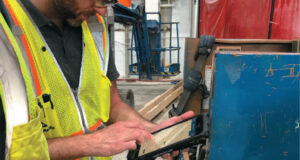THOM KRAMER
The updated OSHA rule on Walking-Working Surfaces and Personal Fall Protection Systems (29 CFR 1910 Subparts D&I) has been in effect for more than a year. The updated regulations can have a major impact on maintaining a compliant fall protection program, but the document in the Federal Register is more than 500 pages and difficult to process. Here’s an overview of the items most likely to affect your fall protection program.
IMPACTS TO ROOF WORK
One of the most common questions related to roof work is: What is a safe distance to an unprotected roof edge? Despite OSHA’s previous stance that there is no safe distance, the new rule provides some clarification. The regulation states that work at less than 6 feet from the roof edge requires conventional means of protection (guardrail, personal fall arrest, etc.). From 6-15 feet, the new rule allows for a designated area for infrequent or temporary work; these are further defined in the rule’s commentary section.
Similar to the construction regulations, a warning line is also required at 6 feet. For work more than 15 feet from a roof edge, the new rule states that the employer is not required to provide any fall protection, provided the work is both infrequent and temporary. In this last case, the language allows for the application of an administrative control and training, preventing workers from getting closer than 15 feet from an unprotected edge.
REQUIREMENT FOR
WORKPLACE ASSESSMENTS
One of the most significant requirements provided in the new rule is the need for the assessment of fall hazards. While Section 1910.132(d) has always required workplace assessment, it now also applies to fall protection. Employers must do the following to avoid non-compliance:
• Determine if fall hazards are present and, when present, communicate to employees, select types of PPE to protect employees, and ensure proper fit of equipment.
• Coordinate with other entities to assess hazards for multi-employer sites.
• Document the completion of assessments, including what workplaces were evaluated, who certified that an evaluation was performed, and the date of the assessment.
NEW INFORMATION FOR LADDERS, STAIRS AND GUARDRAIL
First, the new rule includes additional approved types: alternating tread-type stair, combination ladders, and mobile ladder stand platforms. The rule also now includes specific requirements for spiral stairs and ship stairs. Another major change is that ladder safety systems or personal fall arrest systems will be required on ladders for falls greater than 24 feet. The enforcement of this requirement will start in November 2018 for new ladders.
For guardrail, the general industry regulations are now aligned with the construction rules, requiring a height of 42 inches (+/- 3 inches). The new rule also codifies the requirement that openings cannot be greater than 19 inches.
NEED FOR COMPETENT
AND QUALIFIED PERSONS
The new rule is much more specific about the roles of competent and qualified persons, and indicates distinct training and responsibilities for personnel with these designations. There are specific references to the need for a qualified person for the following:
• Training of workers (historically tied to the competent person)
• When correction or repair involves structural integrity of a walking-working surface
• Inspecting knots in a lanyard or vertical lifeline
• Annual inspection of rope descent anchorages
• Anchorage certification
NO TIME TO WAIT
If your organization has not already reviewed the new regulations, planned for changes, and started implementation, you are behind. The majority of the changes were effective immediately upon publication of the rule in January, 2017. For example, workers exposed to fall hazards or those using fall protection equipment were to receive updated training by May, 2017. Assessment and design change requirements were considered active upon original publication.
Fall protection will remain a focus area for OSHA in the coming years due to the increasing number of fall fatalities and citations related to fall protection. Now’s the time to understand and implement changes to your fall protection program—to reduce risk, improve safety, and facilitate compliance.
Thom Kramer, P.E., C.S.P., is a safety consultant and structural engineer with 23 years of experience, and is managing principal for LJB Inc. Kramer also serves as president of the International Society for Fall Protection and is widely recognized as a thought leader in the occupational safety industry. He recently presented at the Pulp and Paper Safety Association’s 75th Annual Conference in June.
 Paper 360
Paper 360

